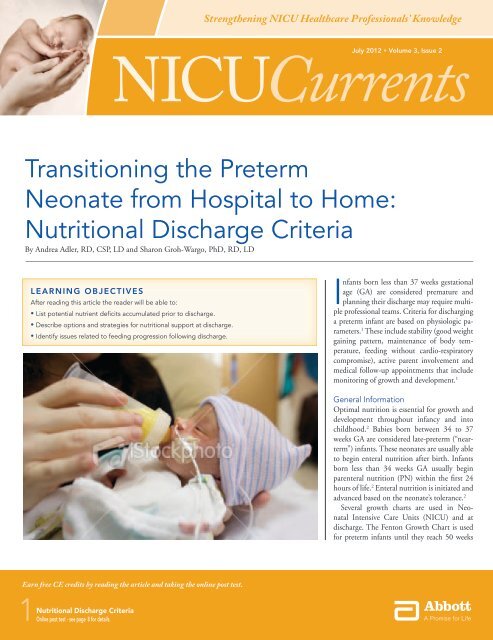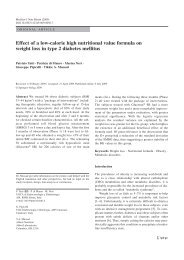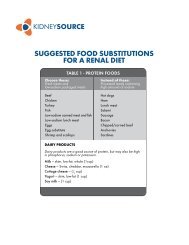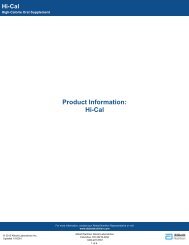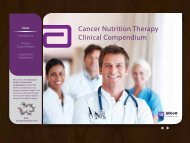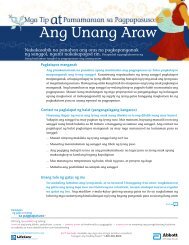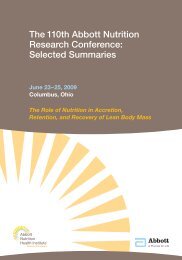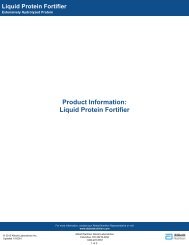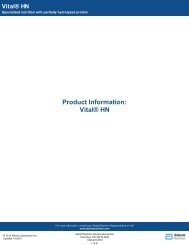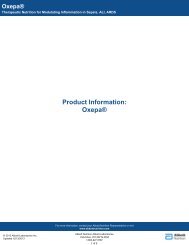Nutritional Discharge Criteria - Abbott Nutrition
Nutritional Discharge Criteria - Abbott Nutrition
Nutritional Discharge Criteria - Abbott Nutrition
You also want an ePaper? Increase the reach of your titles
YUMPU automatically turns print PDFs into web optimized ePapers that Google loves.
Strengthening NICU Healthcare Professionals’ Knowledge<br />
NICUCurrents<br />
July 2012 • Volume 3, Issue 2<br />
Transitioning the Preterm<br />
Neonate from Hospital to Home:<br />
<strong><strong>Nutrition</strong>al</strong> <strong>Discharge</strong> <strong>Criteria</strong><br />
By Andrea Adler, RD, CSP, LD and Sharon Groh-Wargo, PhD, RD, LD<br />
Learning Objectives<br />
After reading this article the reader will be able to:<br />
• List potential nutrient deficits accumulated prior to discharge.<br />
• Describe options and strategies for nutritional support at discharge.<br />
• Identify issues related to feeding progression following discharge.<br />
Infants born less than 37 weeks gestational<br />
age (GA) are considered premature and<br />
planning their discharge may require multiple<br />
professional teams. <strong>Criteria</strong> for discharging<br />
a preterm infant are based on physiologic parameters.<br />
1 These include stability (good weight<br />
gaining pattern, maintenance of body temperature,<br />
feeding without cardio-respiratory<br />
compromise), active parent involvement and<br />
medical follow-up appointments that include<br />
monitoring of growth and development. 1<br />
General Information<br />
Optimal nutrition is essential for growth and<br />
development throughout infancy and into<br />
childhood. 2 Babies born between 34 to 37<br />
weeks GA are considered late-preterm (“nearterm”)<br />
infants. These neonates are usually able<br />
to begin enteral nutrition after birth. Infants<br />
born less than 34 weeks GA usually begin<br />
parenteral nutrition (PN) within the first 24<br />
hours of life. 2 Enteral nutrition is initiated and<br />
advanced based on the neonate’s tolerance. 2<br />
Several growth charts are used in Neonatal<br />
Intensive Care Units (NICU) and at<br />
discharge. The Fenton Growth Chart is used<br />
for preterm infants until they reach 50 weeks<br />
Earn free CE credits by reading the article and taking the online post test.<br />
<strong><strong>Nutrition</strong>al</strong> <strong>Discharge</strong> <strong>Criteria</strong><br />
1Online post test - see page 8 for details.
Feature: <strong><strong>Nutrition</strong>al</strong> <strong>Discharge</strong> <strong>Criteria</strong><br />
post-conceptional age (Figure 1). Once a preterm<br />
infant reaches 40 weeks GA, the American<br />
Figure 1: Fenton Growth Chart 3<br />
Academy of Pediatrics (AAP) and the Center<br />
for Disease Control (CDC) recommend plotting<br />
infants on the World Health Organization<br />
(WHO) growth chart rather than the CDC’s. 4<br />
(Table 1)<br />
The nutrition goal is to bring the nutrient<br />
status of preterm infants to normal as soon<br />
as possible. 10 <strong>Nutrition</strong> recommendations for<br />
catch-up growth of preterm infants exceed<br />
those for term infants. 11 There are no evidencebased<br />
recommendations on when to transition<br />
from using preterm nutrient requirements,<br />
such as the recommendations from ESP-<br />
GHAN, Tsang, or the IOM nutrient requirements.<br />
7,8,9 However, it is speculated that this<br />
change should take place after 40 weeks corrected<br />
GA based on the patient’s clinical status.<br />
Feeding Abilities<br />
Oral-motor skills develop as the fetus grows<br />
in-utero and during the postnatal period. The<br />
majority of preterm infants are not ready to<br />
feed orally at birth. Around 34 weeks GA,<br />
suck-swallow coordination and gag mechanisms<br />
mature; however; suck-swallow-breathe<br />
coordination does not fully develop until 37<br />
weeks GA. 12,13 Infants are transitioned from<br />
gavage feedings to breast or bottle feedings in<br />
preparation for discharge. Patients may be discharged<br />
home with nasogastric feeding tubes if<br />
they are physiologically ready, but still unable<br />
to completely orally feed. 1<br />
In rare instances, a gastrostomy tube (Gtube)<br />
may be needed for an infant to be discharged<br />
home sooner. Conditions that warrant<br />
such feedings include short bowel syndrome,<br />
neurological impairment, marked oral aversion,<br />
inability to consume sufficient volume<br />
from nipple feeding or congenital anomalies.<br />
12,14 Care is taken not to overfeed via the<br />
G-tube as that may cause the device to leak<br />
formula or gastric content onto the skin. 14<br />
Human Milk/Breastfeeding<br />
Human milk has a unique composition,<br />
helping protect against childhood obesity,<br />
Crohn’s disease, lymphoma, leukemia and<br />
diabetes. 2 It also decreases the incidence of<br />
diarrhea and necrotizing enterocolitis. 2,12,15<br />
Human milk contains docosahexaenoic acid<br />
(DHA) and arachidonic acid(ARA), two<br />
long chain poly-unsaturated fatty acids that<br />
play a role in visual acuity, growth and cognitive<br />
development. 2,12<br />
2 | July 2012 NICU Currents
As with full-term neonates, human milk offers<br />
advantages to preterm infants. Despite higher<br />
amounts of nutrients compared to term milk,<br />
preterm human milk does not contain optimal<br />
nutrition to promote growth in preterm infants.<br />
16 Preterm milk composition transitions<br />
to term milk composition around 4 weeks after<br />
a preterm infant is born. 17 Cochrane Reviews report<br />
that fortifying human milk supports shortterm<br />
weight gain, length and head circumference<br />
growth and possible increases in bone<br />
mineral content (BMC). 10<br />
Little evidence is available to guide planning<br />
for the discharge of human-milk-fed preterm infants.<br />
O’Connor et al studied the effects of adding<br />
commercial human milk fortifier to half of<br />
human milk feeds for 12 weeks after discharge.<br />
The intervention group showed improvements<br />
over the first year of life in weight, length,<br />
BMC, and head circumference measurements,<br />
compared to the control group receiving unfortified<br />
human milk. The intervention group<br />
also showed a trend in successful completion of<br />
language and motor skills on the Bayley Index<br />
II scales. 19 Even so, fortification did not increase<br />
percent body fat or trunk-fat mass. 18,19<br />
On the other hand, research by Zachariassen<br />
et al showed that small amounts of fortification<br />
added to human milk until 4 months<br />
CA did not significantly affect growth at 1 year<br />
CA, compared to feeding human milk alone. 20<br />
However, the increased amount of protein and<br />
phosphorus improved BUN levels—a marker<br />
for protein synthesis—and serum phosphorus<br />
levels, which may potentially improve growth. 20<br />
Birth weight, discharge weight, risk factors,<br />
and serum levels should all be taken into account<br />
to determine if the preterm infant at discharge<br />
can be adequately fed with human milk<br />
alone. When indicated, fortification can be<br />
added in several ways: (1) addition of commercial<br />
human milk fortifier to expressed human<br />
milk (under close medical supervision), (2) two<br />
to four feedings per day of nutrient-enriched<br />
formula along with breastfeeding or (3) addition<br />
of nutrient-enriched formula powder to<br />
expressed human milk to increase the caloric<br />
density (more accurately called ‘enrichment’).<br />
Option one, using commercial human<br />
milk fortifier, may be indicated for extremely<br />
low–birth-weight infants who are still small at<br />
discharge, infants who have continuing medical<br />
problems such as bronchopulmonary dysplasia<br />
(BPD), and/or have BUN levels less than 9 mg/<br />
dL, alkaline phosphatase levels higher than 600<br />
U/L or phosphorus levels less than 5 mg/dL.<br />
Option three adds energy but little additional<br />
protein or micronutrient content. Although<br />
there are currently no recommendations about<br />
fortification of human milk after discharge,<br />
Table 1: Description of Growth Charts 3,4,5,6<br />
Growth Chart Type of Curve Age Pros Cons<br />
Fenton<br />
Intrauterine<br />
growth chart<br />
(representing<br />
ideal fetal<br />
growth) and<br />
postnatal<br />
growth chart<br />
22–50 weeks • More recent chart<br />
• Data based on meta-analysis<br />
• Weight is smoothed between 36–46<br />
weeks GA; length and head circumference<br />
are smoothed at 22 weeks, to connect<br />
intrauterine growth and post term growth.<br />
• Follow-up limited to 2 months CGA<br />
• Does not account for initial<br />
postnatal weight loss<br />
• Preterm infants’ growth typically<br />
does not exceed the intrauterine<br />
growth curve<br />
• Anthropometrics obtained from<br />
different infants with different<br />
gestational ages.<br />
Olsen<br />
Intrauterine<br />
growth chart<br />
(representing<br />
ideal fetal<br />
growth)<br />
23–41 weeks • Recent growth chart accounting for medical<br />
advances in the last 3-4 decades<br />
• Large, racially-diverse population from US<br />
data<br />
• Gender specific<br />
• Compares weight, length and head<br />
circumference for the same infant<br />
• Newer statistics for birth classification by GA<br />
(small, appropriate, or large)<br />
• Data validated on separate subsamples<br />
• Good chart for young babies at immediate<br />
post-discharge.<br />
• May not be representative of all<br />
infants, especially of older GA, as<br />
data was obtained only on infants<br />
admitted to the NICU.<br />
World Health<br />
Organization<br />
(WHO)<br />
Postnatal<br />
growth chart<br />
(reflects initial<br />
weight loss<br />
after birth)<br />
Term and<br />
preterm<br />
infants at 40<br />
weeks CGA-<br />
23 months<br />
of age<br />
• Shows how children should grow for best<br />
health outcomes<br />
• Multi-regional data<br />
• Separate charts for boys and girls.<br />
• Only used for preterm infants at 40<br />
weeks corrected age<br />
• Doesn’t show “catch-up” growth.<br />
NICU Currents July 2012 | 3
Feature: <strong><strong>Nutrition</strong>al</strong> <strong>Discharge</strong> <strong>Criteria</strong><br />
based on available research 18,19,20 the authors recommend<br />
the following parameters for consideration<br />
of fortification after discharge. See Table 2<br />
for a nutrient comparison of the three options.<br />
Infant Formulas<br />
Preterm infant formulas (Similac ® Special<br />
Care ® or Enfamil ® Premature Formula) are<br />
recommended in the NICU if human milk<br />
is not available for infants with a birth weight<br />
2,000g, or as a transition formula from<br />
the hospital to home. 21,22,24 These formulas<br />
contain a nutrient composition greater than<br />
term -infant formulas but less than preterm<br />
infant formulas. Depending on birth weight,<br />
nutrient enriched formulas are recommended<br />
through 12 months corrected gestational<br />
age (CGA). Infants (especially those less than<br />
1,250 grams at birth) on nutrient enriched<br />
formula until 9-12 months CGA show improvement<br />
in bone growth/mineralization<br />
and growth when compared to preterm infants<br />
fed standard term formula. 24<br />
Cochrane Reviews evaluated seven studies<br />
of preterm infants fed either a nutrientenriched<br />
formula or a standard term infant<br />
formula at discharge. The studies found no<br />
strong evidence that at 18 months CGA,<br />
nutrient-enriched formula supported better<br />
growth and development than standard-term<br />
formula. 25 Between term and 6 months CA,<br />
preterm infants on nutrient-enriched formula<br />
may gain more lean mass and less fat mass<br />
than preterm infants fed standard-term formula.<br />
26 Regarding use of nutrient-enriched<br />
formulas, the AAP and the American College<br />
of Obstetricians and Gynecologists recommend<br />
that “Small, preterm neonates (born at<br />
or before 34 weeks of gestation, with a birth<br />
weight less than or equal to 1,800 g) and neo-<br />
Table 2: Composition of Human Milk and Formulas 21,22<br />
Nutrient per<br />
100 calories<br />
Human<br />
Milk<br />
Human Milk<br />
+ Nutrient<br />
Enriched<br />
Formula ~<br />
24 cal/oz<br />
Human Milk as the Base Preterm Formula Nutrient Enriched Formula<br />
Human Milk<br />
alternating<br />
with<br />
Nutrient<br />
Enriched<br />
Formula ~<br />
Human<br />
Milk +<br />
HMF ~<br />
24 cal/oz<br />
Enfamil ®<br />
Similac ®<br />
Care ® Formula<br />
Special Premature<br />
Similac Enfamil ®<br />
Expert EnfaCare ®<br />
Care <br />
NeoSure ®<br />
Energy, Cal 100 100 100 100 100 100 100 100<br />
Protein, g 1.5 1.8 2.2 2.9 3.0 3.0 2.8 2.8<br />
Vit A, IU 331 344 366 1222 1250 1250 350 450<br />
Vit D, IU 3 15 37 172 150 240 70 70<br />
Calcium, mg 41 54 77 162 180 165 105 120<br />
Phos, mg 21 29 43 89 100 83 62 66<br />
Iron, mg 0.04 0.35 0.9 1.1 1.8 1.8 1.8 1.8<br />
Zinc, mg 0.18 0.35 0.6 2.5 1.5 1.5 1.2 1<br />
Mixing<br />
instructions<br />
NA<br />
75ml breast<br />
milk + 1<br />
teaspoon<br />
nutrient<br />
enriched<br />
formula<br />
powder<br />
Alternate<br />
feeds of<br />
human milk<br />
and nutrient<br />
enriched<br />
formula<br />
22 calorie/<br />
ounce<br />
25 ml<br />
breast milk<br />
+ 1 packet<br />
per vial<br />
HMF<br />
NA NA NA NA<br />
Note: Human milk is based on assumed composition of term human milk<br />
~ indicates an average of Similac ® and Enfamil ® products; Similac ® products are made by <strong>Abbott</strong> <strong>Nutrition</strong> in Columbus, Ohio and Enfamil ® products<br />
are made by Mead Johnson <strong>Nutrition</strong> in Evansville, Illinois<br />
4 | July 2012 NICU Currents
Table 3: Commonly Used NICU Medications at <strong>Discharge</strong> and Nutrient Interactions 32,34-37<br />
Medication Usage Interaction<br />
Caffeine Apnea of prematurity May cause nausea, vomiting, GI intolerance, necrotizing enterocolitis, or GI hemorrhage.<br />
Chlorothiazide Diuretic Monitor electrolytes, Ca, Phos, glucose. Delay in growth due to low serum Na, K, and Cl,<br />
which may need to be supplemented. Decreases renal excretion of Ca. Caution with Ca<br />
supplements due to an increased risk for nephrocalcinosis. May cause nausea, vomiting,<br />
constipation, or GI intolerance.<br />
Digoxin Antiarrhythmic May decrease K and Mg or increase Ca and Mg. May cause feeding intolerance, nausea,<br />
vomiting, or diarrhea. Caution with calcium and vitamin D supplements.<br />
Erythropoietin Stimulates erythropoiesis Increased iron needs.<br />
Famotidine H2 antagonist May cause constipation, diarrhea, nausea, or vomiting. Increased risk for late-onset bacterial<br />
and fungal sepsis, however no short-term adverse effects have been seen.<br />
Furosemide Diuretic Monitor serum and urine electrolytes and renal function throughout duration of usage.<br />
May cause nephrocalcinosis or nephrolithiasis. Monitor weight and fluid status. Bone<br />
demineralization may occur with long-term usage.<br />
Metoclopramide Prokinetic GI agent May improve feeding intolerance. May cause increase in irritability or vomiting, nausea,<br />
diarrhea or constipation.<br />
Phenobarbital Anticonvulsant May decrease serum Ca, vitamin K, vitamin B12, vitamin C, vitamin D, and folate. May cause<br />
decreased bone density. May cause nausea, vomiting, constipation, or megaloblastic anemia.<br />
Ca: calcium; Cl: chloride; GI: gastrointestinal; K: potassium; Mg: magnesium; Na: sodium;<br />
Phos: phosphorous<br />
nates with other morbidities (e.g. BPD) may<br />
benefit from the use of such formulas for up<br />
to 9 months after hospital discharge.” 27<br />
Standard term infant formula can be used<br />
if human milk is not available for late-preterm<br />
(near-term) infants. 23 Standard term formulas<br />
have compositions similar to that of term<br />
human milk. However, they are not recommended<br />
for preterm infants, even at discharge,<br />
because of their inadequate nutrient density. 23<br />
Soy infant formulas are also not recommended<br />
for preterm infants. According to the 2008<br />
AAP statement on soy infant formulas, preterm<br />
infants receiving soy infant formulas had lower<br />
serum phosphorous levels and higher alkaline<br />
phosphatase levels than preterm infants fed the<br />
standard term cow’s milk based formula. 28 Even<br />
with calcium and Vitamin D supplementation,<br />
preterm infants fed soy formula are at risk for<br />
metabolic bone disease. 28<br />
Although hydrolyzed and elemental formulas<br />
are not intended for premature infants,<br />
sometimes they are better tolerated, allowing<br />
for more rapid advancement to full enteral<br />
feeding. 30 Hydrolyzed formulas are hypoallergenic;<br />
they reduce the risk of allergic reaction<br />
to cow’s milk protein. 23 Elemental (amino acidbased)<br />
formulas are non-allergenic; they do not<br />
contain milk protein, fructose, galactose, lactose,<br />
gluten or soy protein. 22,29 These formulas<br />
are used for severe cow’s milk protein allergy or<br />
other food protein allergies. Additional vitamin<br />
and mineral supplementation may be necessary<br />
when hydrolyzed protein or elemental formulas<br />
are fed to preterm infants. 12<br />
Table 2 lists common formulas used in the<br />
NICU and at discharge, along with their nutrient<br />
composition. Refer to product handbooks<br />
for specific recipes to enrich human milk with<br />
nutrient-enriched formula or for increased caloric<br />
density formula recipes. 21,22<br />
Vitamins and Minerals<br />
Common supplements prescribed at discharge<br />
include Vitamin D and iron (Fe). Other supplements<br />
may also be prescribed, including calcium,<br />
phosphorous, zinc (Zn) and electrolytes.<br />
Vitamin D deficiency is a common problem<br />
across the human lifespan. In 2008, the<br />
AAP recommended supplementation of 400<br />
International Units of vitamin D for all infants,<br />
starting within the first few days of life. 31<br />
Infants receiving human milk, even if supplemented<br />
with some formula, should receive a<br />
liquid multivitamin throughout the first year<br />
of life. 31 Formula-fed infants should receive<br />
the vitamin D supplement until they consume<br />
at least 1 liter of formula a day. 31<br />
The AAP recommends that preterm infants<br />
receive 2-4mg Fe/kg/day. 32 Commercial<br />
iron-fortified formula provides 2mg Fe/<br />
kg/day and unfortified breast milk provides<br />
0.5mg Fe/kg/day (based on the infant’s<br />
receiving 150ml/kg/day). Preterm infants<br />
receiving human milk should continue Fe<br />
supplements until weaned to formula, or are<br />
eating 2mg Fe/kg in complementary foods. 32<br />
Ferrous sulfate is the most effectively absorbed<br />
form of iron for the newborn. 2<br />
Depending on a diagnosis of illness (i.e.<br />
metabolic bone disease), medications used at<br />
discharge, or the formula being fed, premature<br />
infants may require additional mineral<br />
supplementation. Since soy protein, hydrolyzed<br />
protein and elemental formulas are not<br />
intended for premature infants, calcium and<br />
phosphorous supplementation may be needed.<br />
Supplemental Zn may be beneficial in preterm<br />
infants receiving unfortified human milk. 33<br />
Table 3 reviews the common medications that<br />
preterm infants may receive after discharge.<br />
NICU Currents July 2012 | 5
Feature: <strong><strong>Nutrition</strong>al</strong> <strong>Discharge</strong> <strong>Criteria</strong><br />
Table 4 lists the composition of the most common<br />
vitamin and mineral supplements.<br />
<strong>Nutrition</strong> Problems: Feeding intolerance<br />
Feeding intolerance is common in preterm<br />
infants. The most common problems include<br />
uncontrolled reflux, spit-ups and constipation.<br />
In addition, there may be medical<br />
conditions associated with feeding intolerance,<br />
such as gastroesophageal reflux disease<br />
or necrotizing enterocolitis associated with<br />
short bowel syndrome.<br />
Gastroesophageal Reflux<br />
Prematurity is a risk factor for gastroesophageal<br />
reflux (GER). GER occurs when stomach<br />
contents move up the esophagus and<br />
possibly into the mouth. In some cases, GER<br />
is a symptom of gastroesophageal reflux disease<br />
(GERD). 38<br />
Three to ten percent of premature infants<br />
weighing less than 1,500 grams have symptomatic<br />
GER. 38 Positioning and dietary<br />
changes are two methods that may help treat<br />
symptomatic GER. Interventions for GER are<br />
discussed in the article entitled: “Evidencebased<br />
treatment of gastroesophageal reflux in<br />
neonates” by Susan Pfister, RN, CNNP, MA<br />
in the June 2012 issue of Nurse Currents.<br />
Compared to formula feeding, human<br />
milk feeding results in shorter episodes of<br />
reflux. It is controversial if changing the type<br />
of formula or milk alters the incidence or severity<br />
of reflux. 35,38 In case of GER, the type<br />
of feed may be changed for a 1-2 week trial.<br />
If no improvement is seen, the infant should<br />
be changed back to the previous formula, as<br />
appropriate for age and other clinical conditions.<br />
35 Small, frequent feeds decrease the<br />
incidence of reflux. 35,38<br />
Thickening the feeds with rice cereal. It is<br />
not physiologically appropriate for preterm<br />
infants, and may cause constipation. 38 Commercial<br />
anti-reflux formulas that thicken<br />
upon contact with gastric contents should<br />
be used with caution, as they do not meet<br />
the nutritional requirements of premature<br />
or former premature infants. 35,38 Anti-reflux<br />
formulas have been shown to reduce the<br />
amount and severity of reflux. However, the<br />
affect of the additional thickening in the<br />
anti-reflux formula may be reduced if the<br />
infant is on H2 blockers. 35 In May 2011,<br />
the Food and Drug Administration (FDA)<br />
recommended that ‘Simply Thick’, a gumbased<br />
thickener, not be used in infants born<br />
premature (
charge. 41 Since some infants who go home<br />
on unfortified breast milk develop MBD<br />
post-discharge, continuation of human milk<br />
fully or partially fortified with commercial<br />
human milk fortifier should be considered,<br />
especially for extremely low birth weight infants<br />
or infants with abnormal phosphorus<br />
and/or alkaline phosphatase levels. 41<br />
Commercial human milk fortifiers are<br />
difficult to obtain outside of the hospital.<br />
Infants who are provided with human<br />
milk fortifiers at hospital discharge must be<br />
closely monitored. Formula-fed infants with<br />
a history of MBD are candidates for continuation<br />
of preterm infant formula. Picaud<br />
et al found that two months after discharge,<br />
preterm infants fed commercial preterm<br />
formula had better gains in weight, head<br />
circumference, and bone mineral content<br />
(BMC) and BMD, compared to the infants<br />
fed term formula. 42<br />
Treating MBD may be accomplished in<br />
several ways. Infants who weigh
Feature: <strong><strong>Nutrition</strong>al</strong> <strong>Discharge</strong> <strong>Criteria</strong><br />
Table 5: Growth Parameters for Term Infants or Preterm<br />
Infants Corrected to Term 48<br />
Age Weight Length Head Circumference<br />
0-3 months 25-35 grams/day 2.5-3.5 cm/week 0.5 cm/week<br />
3-6 months 15-21 grams/day 1.6-2.5 cm/week 0.5 cm/week<br />
6-12 months 10-13 grams/day 1.2-1.7 cm/week 0.5 cm/week<br />
Table 6: Calculating Corrected Gestational Age (CGA)<br />
(Weeks premature + weeks old) – 40 weeks = CGA in weeks<br />
Example: An infant was born at 28 weeks GA and is now 16 weeks old.<br />
(28 weeks + 16 weeks) – 40 weeks = 4 weeks old (1 month old) CGA<br />
On the growth chart, this infant would be plotted at 1 month to correct for prematurity.<br />
age. 2 <strong>Nutrition</strong> intervention after hospital<br />
discharge is crucial to improve long-term<br />
growth and neurodevelopment. 50,51 About<br />
80% of very low birth weight and/or small<br />
for SGA infants who experience postnatal<br />
growth failure show catch-up growth by<br />
two to three years of age. 51 Occasionally,<br />
catch-up growth may occur between eight<br />
years of age and adolescence. 11 In rare cases<br />
little catch-up occurs and the child remains<br />
small into adulthood. 15,50,52<br />
There is increasing evidence that very<br />
rapid catch-up growth may have adverse<br />
long-term effects, including increased risk<br />
for hypertension, cardiovascular disease,<br />
diabetes, and osteoporosis. 51 Catch-up<br />
growth associated with an increase in central<br />
fat mass, but not lean mass and gains<br />
in length, leads to metabolic syndrome<br />
later in life. 53 Once the infant is term-corrected<br />
age, it is important to monitor the<br />
weight-to-length ratio. Cooke et al showed<br />
that earlier catch-up growth was healthier<br />
and more complete when infants were fed<br />
commercial preterm infant formula until<br />
6 months CA. These babies showed an<br />
increase in fat-free and peripheral fat mass<br />
without an increase in adiposity. 53<br />
According to Lucas [W]hile slow growth<br />
(below the intrauterine rate) has some benefit<br />
for later cardiovascular outcome, it risks<br />
under-nutrition and its adverse consequences,<br />
and has a profound adverse effect on later<br />
cognition. Currently, the balance of risks favors<br />
the brain, and preterm infants should be<br />
fed with specialized products to support rapid<br />
growth (at least at the intrauterine rate). 4 If<br />
there is concern for rapid weight gain on<br />
a nutrient-enriched formula, it may be<br />
diluted from the standard concentration<br />
of 22 calories/ounce to 20 calories/ounce.<br />
The lower caloric density of the nutrient<br />
enriched formula will continue to provide<br />
higher protein and micronutrient density<br />
compared to standard term formula.<br />
Corrected Gestational Age<br />
Preterm infants should not be expected<br />
to reach developmental milestones at the<br />
same time as term infants. Adjusting for<br />
prematurity or referring to the CGA is<br />
recommended for at least the first year,<br />
possibly up to 3½ and, in some instances,<br />
through seven years of life. 3,40 Table 6 provides<br />
the equation to calculate CGA, including<br />
an example.<br />
A preterm infant’s CGA is used to assess<br />
developmental milestones, growth, and<br />
feeding. Once a preterm infant reaches 40<br />
weeks GA, growth can be plotted on the<br />
WHO growth chart. 40 Developmental age<br />
is used to evaluate readiness for spoon feeding.<br />
55 Most authorities recommend initiating<br />
solid food from a spoon at 4-6 months<br />
CGA. 24,40,56 Starting spoon feedings before<br />
recommended CGA may contribute to<br />
feeding problems. Introducing solid foods<br />
into the infant’s diet may decrease formula<br />
consumption and, if the solid foods are of<br />
poor nutritional quality, may compromise<br />
growth. 52 The use of whole milk is not recommended<br />
until one year CGA. 24,40,56<br />
Post-discharge Follow-Up<br />
After discharge from the hospital, premature<br />
infants should be examined and tested<br />
to identify any medical or neurodevelopmental<br />
problems. 40,57 Some follow-up<br />
clinics also monitor growth, development<br />
and nutrition. 56 In addition to medical<br />
appointments, participation in programs<br />
offering home visiting nurses, Early Intervention,<br />
and Women, Infants, and Children<br />
(WIC) services are available. These<br />
provide support to low-income families in<br />
need of therapies, infant formulas and nutritious<br />
food. 40,56,58<br />
A preterm infant should be seen within<br />
one week of discharge. 40 NICU follow-up<br />
clinics are often multidisciplinary in nature,<br />
and frequently include dietitians. 56<br />
Improving the nutritional status of the preterm<br />
infant obviously minimizes adverse<br />
developmental outcomes. 56 A dietitian<br />
should be consulted for the following: absence<br />
of catch-up growth, weight loss after<br />
hospital discharge, falling off the attained<br />
growth curve or falling below the fifth percentile<br />
on the growth chart. 40 Follow-up by<br />
dietitians facilitates the catch-up growth of<br />
very low birth weight infants through 12<br />
months CGA. 57 A dietitian should see any<br />
patients who are on concentrated or specialty<br />
formulas, on PN, or who have a G-<br />
tube to assess tolerance. These infants need<br />
to be monitored for electrolyte disturbances<br />
and tolerance of formula. 40 Where the<br />
infant is seen is also important. One study<br />
reports that infant growth parameters were<br />
significantly better at a comprehensive care<br />
(NICU follow-up) clinic than at a general<br />
practice clinic. 57<br />
The infant may also need follow-up<br />
appointments with subspecialists, such as<br />
cardiologists, gastroenterologists, neurologists<br />
or surgeons, or at a multi-disciplinary<br />
8 | July 2012 NICU Currents
Post-Test:<br />
Transitioning the Preterm Neonate from Hospital to Home:<br />
<strong><strong>Nutrition</strong>al</strong> <strong>Discharge</strong> <strong>Criteria</strong><br />
Complete the quiz on line at www.anhi.org at no charge. Please note online questions or answers are randomized and may not appear<br />
in the same sequence below. Do not assume that the “letter” preceding the correct response will be identical to the online version.<br />
1. There are no up-to-date, easily accessible<br />
national standards for nutrient requirements<br />
in preterm infants in the US.<br />
a. True<br />
b. False<br />
1. Which of the following diagnoses are<br />
common for a preterm infant<br />
a. Metabolic bone disease<br />
b. Necrotizing enterocolitis<br />
c. Bronchopulmonary dysplasia<br />
d. All of the above<br />
2. All of the following provide complete<br />
nutrition for preterm infants except:<br />
a. Human milk<br />
b. Enriched formula<br />
c. Preterm formula<br />
3. All of the following are nutritional complications<br />
of necrotizing enterocolitis except:<br />
a. Feeding intolerance<br />
b. Ostomy<br />
c. Lung disease<br />
d. Short bowel syndrome<br />
4. Including a dietitian in the NICU follow-up<br />
program:<br />
a. Decreases weight gain<br />
b. Improves the nutritional status of preterm<br />
infants.<br />
c. Decreases the nutritional status of preterm<br />
infants.<br />
d. Ensures provision of infant formula<br />
samples.<br />
5. Risk factors for metabolic bone disease<br />
include:<br />
a. Prematurity<br />
b. Preterm infant receiving unfortified<br />
human milk<br />
c. Preterm infant receiving<br />
hydrolyzed formula<br />
d. All of the above<br />
6. Preterm infants have lower nutrient requirements<br />
than term infants because<br />
they are smaller.<br />
a. True<br />
b. False<br />
7. Gastroesophageal reflux is a common<br />
problem with preterm infants.<br />
a. True<br />
b. False<br />
8. Preterm infants who suffer from SBS due<br />
to NEC:<br />
a. Are at risk for developing strictures<br />
b. Are not known to have<br />
nutritional deficiencies<br />
c. Easily tolerate any type of formula<br />
(if human milk is not available)<br />
9. Infants with severe BPD have higher<br />
calorie needs.<br />
a. True<br />
b. False<br />
10. Few preterm infants develop extrauterine<br />
growth restriction.<br />
a. True<br />
b. False<br />
11. Corrected gestational age should be used in:<br />
a. Adjusting for developmental milestones<br />
b. Deciding when to initiate solid foods<br />
c. Assessing growth<br />
d. All of the above<br />
12. Common vitamin and/or mineral supplements<br />
for preterm infants are:<br />
a. Zinc, Na and Cl<br />
b. Vitamin D and Fe<br />
c. Vitamin D and Vitamin A<br />
13. Anthropometrics for a preterm infant<br />
prior to term corrected age should be assessed<br />
on:<br />
a. CDC growth chart<br />
b. WHO growth chart<br />
c. Fenton growth chart<br />
d. None of the above<br />
14. Preterm human milk transitions to term<br />
human milk composition around:<br />
a. 2 weeks<br />
b. 4 weeks<br />
c. 6 weeks<br />
d. 8 weeks<br />
15. Ideally, preterm infants are followed by a<br />
multidisciplinary team.<br />
a. True<br />
b. False<br />
Credit: 1<br />
<strong>Abbott</strong> <strong>Nutrition</strong> Health Institute, is an approved provider of continuing nursing education by the California Board of Registered<br />
contact Nursing Provider #CEP 11213.<br />
NICU Currents July 2012 | 9<br />
hour
Feature: <strong><strong>Nutrition</strong>al</strong> <strong>Discharge</strong> <strong>Criteria</strong><br />
Several conditions that are diagnosed in preterm infants during<br />
the NICU hospital stay, including GER, MBD, NEC, and BPD,<br />
may be impacted by their nutrition following discharge.<br />
infant feeding clinic. 40,55 Feeding clinics<br />
often have both inpatient and outpatient<br />
programs to manage feeding disorders.<br />
These are common in premature infants<br />
due to repeated exposure to noxious oral<br />
stimuli and the greater length of time<br />
until oral feeding skills develop. 55 Feeding<br />
disorders usually start as a physiological<br />
problem and can then develop into a<br />
behavioral or psychological problem. 55<br />
Identification of the particular problem<br />
and corrective actions by a feeding clinic<br />
team have a significant impact on the<br />
growth and development of the premature<br />
infant. 56 Left untreated, feeding problems<br />
can lead to failure to thrive, malnutrition,<br />
or impaired intellect. 55<br />
Conclusion<br />
Premature infants have higher nutritional<br />
needs than term infants. Preterm infants<br />
are at high nutritional risk following hospital<br />
discharge. Human milk is the ideal<br />
feeding after discharge but it may require<br />
fortification or enrichment to meet the nutritional<br />
needs of the preterm. Appropriate<br />
choices at discharge of the preterm infant<br />
are nutrient-enriched formulas, for most<br />
babies, or specialized preterm formulas, for<br />
selected babies. Routine supplementation<br />
should include vitamin D and iron. Preterm<br />
infants who are discharged without<br />
nutrient-enriched formulas may require additional<br />
vitamin and mineral supplements.<br />
Several conditions that are diagnosed in<br />
preterm infants during the NICU hospital<br />
stay, including GER, MBD, NEC, and<br />
BPD, may be impacted by their nutrition<br />
following discharge. Preterm infants are often<br />
involved in several follow-up programs,<br />
many of which are multidisciplinary. Continued<br />
research and expanded evidencebased<br />
practices are needed to improve the<br />
post-hospital nutritional management and<br />
long-term outcome of preterm infants.<br />
About the Authors<br />
Andrea Adler RD, CSP, LD is a neonatal<br />
dietitian at the Cleveland Clinic with 7<br />
years of clinical experience. She is the current<br />
secretary of the Ohio Neonatal <strong>Nutrition</strong>ists<br />
group. She also presents lectures<br />
about neonatal nutrition to interdisciplinary<br />
medical teams.<br />
Sharon Groh-Wargo, PhD, RD, LD has<br />
practiced as a neonatal dietitian for more<br />
than 25 years. As a recognized expert in the<br />
field of neonatal nutrition, Dr. Groh-Wargo<br />
has written numerous publications and<br />
speaks widely on the topic of nutrition for<br />
the high-risk newborn. She is a contributor<br />
to the American Dietetic Association’s<br />
(ADA) online Pediatric <strong>Nutrition</strong> Care<br />
Manual and is an editor of the ADA’s Pocket<br />
Guide to Neonatal <strong>Nutrition</strong>.<br />
References<br />
1. American Academy of Pediatrics Committee<br />
on Fetus and Newborn: Hospital discharge<br />
of the high-risk neonate Pediatrics<br />
2008; 122:1119.<br />
2. Gregory K: Update on nutrition for preterm<br />
and full-term infants JOGNN 2005; 34:98.<br />
3. Fenton T: A new growth chart for preterm<br />
babies: Babson and Benda’s chart updated<br />
with recent data and a new format BMC Pediatrics<br />
2003; 3:13.<br />
4. Greer F, Bhatia J: Centers for Disease Control<br />
and Prevention: Use WHO growth<br />
charts for children under 2 AAP News 2010;<br />
31(11).<br />
5. Olsen I, Groveman S, Lawson L, et al: New<br />
intrauterine growth curves based on United<br />
States data Pediatrics 2010; 125:e214.<br />
6. Moyer-Mileur L, Thompson M: “<strong>Nutrition</strong><br />
Assessment” ADA Pocket Guide to Neonatal<br />
<strong>Nutrition</strong> Chicago: American Dietetic Association,<br />
2009. Pages 1-28.<br />
7. Agostoni C, Buonocore G, Carnielli VP, et al:<br />
Enteral nutrient supply for preterm infants:<br />
Commentary from the European Society<br />
for Paediatric Gastroenterology, Hepatology,<br />
and <strong>Nutrition</strong> Committee on <strong>Nutrition</strong><br />
JPGN 2010; 50:1.<br />
8. Tsang R, Uauy R, Koletzko B, Zlotkin S, ed:<br />
<strong>Nutrition</strong> of the preterm infant: Scientific basis<br />
and practical guidelines, ed 2. Cincinnati:<br />
Digital Educational Publishing Inc, 2005.<br />
9. Institute of Medicine: <strong>Nutrition</strong> recommendations:<br />
Dietary reference intakes<br />
(DRI). http://ods.od.nih.gov/Health_Information/Dietary<br />
Reference_Intakes.<br />
aspx; Accessed December 2011.<br />
10. Kuschel CA, Harding JE: Multicomponent<br />
fortified human milk for promoting<br />
growth in preterm infants Cochrane Database<br />
of Syst Rev 2009; (1): CD000343.<br />
11. Heird W: Determination of nutritional<br />
requirements in preterm infants, with<br />
special reference to ‘catch-up’ growth<br />
Semin Neonatol 2001; 6:365.<br />
12. Sapsford A: Enteral <strong>Nutrition</strong> ADA Pocket<br />
Guide to Neonatal <strong>Nutrition</strong>. Chicago,:<br />
American Dietetic Association, 2009.<br />
13. Volpe, J: “Neurological Evaluation” Neurology<br />
of the Newborn, ed 5, Philadelphia:<br />
Saunders, 2008.<br />
14. Bordewick A, Bildner J, Burd R: An effective<br />
approach for preventing and treating<br />
gastrostomy tube complications in<br />
newborns Neonatal Netw 2001; 20:37.<br />
15. Cooke RJ, Embleton ND: Feeding issues<br />
in preterm infants Arch Dis Child Fetal<br />
Neonatal Ed 2000; 83: F215.<br />
16. Rigo J: “Protein, amino acid and other<br />
nitrogen compounds.” Lucas A, Tsang<br />
RC, Uauy R, eds: <strong>Nutrition</strong> of the Preterm<br />
Infant: Scientific Basis and Practical<br />
guidelines, ed 2, Cincinnati, OH: Digital<br />
Educational Publishing Inc; 2005.<br />
17. Lemons J, Moye L, Hall D, et al: Differences<br />
in the composition of preterm and<br />
term human milk during early lactation<br />
Pediatr Res 1982; 16:113.<br />
18. O’Connor D, Khan S, Weishuhn K, et al:<br />
Growth and nutrient intakes of human<br />
milk fed preterm infants provided with<br />
extra energy and nutrients after hospital<br />
discharge Pediatrics 2008; 121: 766.<br />
19. Aimone A, Rovet J, Ward W, et al:<br />
Growth and body composition of human<br />
milk-fed premature infants provided<br />
with extra energy and nutrients early af-<br />
10 | July 2012 NICU Currents
ter hospital discharge: 1-year follow-up<br />
JPGN 2009; 49: 456.<br />
20. Zachariassen G, Faerk J, Grytter C, et<br />
al: Nutrient enrichment of mother’s milk<br />
and growth of very preterm infants after<br />
hospital discharge Pediatrics 2011; 127:1.<br />
21. Mead Johnson <strong>Nutrition</strong>: Pediatric Products<br />
Handbook Mead Johnson and Company,<br />
Evansville, IL: January 2011.<br />
22. <strong>Abbott</strong> <strong>Nutrition</strong>: Pediatric <strong>Nutrition</strong> Product<br />
Guide 2011. Columbus, OH: <strong>Abbott</strong><br />
Laboratories: December 2010.<br />
23. Yu V, Simmer K: Enteral nutrition: Practical<br />
aspects, strategy, and management. Lucas<br />
A, Tsang RC, Uauy R, eds: <strong>Nutrition</strong> of the<br />
preterm infant: Scientific basis and practical<br />
guidelines, ed 2. Cincinnati, OH: Digital<br />
Educational Publishing Inc,” 2005.<br />
24. Groh-Wargo, S: <strong>Discharge</strong> and follow-up.<br />
ADA Pocket Guide to Neonatal <strong>Nutrition</strong>. Chicago:<br />
American Dietetic Association, 2009.<br />
25. Henderson G, Fahey T, McGuire W: Nutrient-enriched<br />
formula versus standard term<br />
formula for preterm infants following hospital<br />
discharge Cochrane Database of Syst<br />
Rev 2009; (4): CD004694.<br />
26. Amesz E, Schaafsma A, Cranendonk A, et<br />
al: Optimal growth and lower fat mass in<br />
preterm infants fed a protein-enriched postdischarge<br />
formula JPGN 2010; 50:200.<br />
27. American Academy of Pediatrics and American<br />
College of Obstetrics and Gynecology:<br />
Guidelines for Perinatal Care, ed 6. Elk<br />
Grove Village, IL: American Academy of Pediatrics,<br />
2007.<br />
28. Bhatia J, Greer F: Use of soy protein-based<br />
formulas in infant feeding Pediatrics 2008;<br />
121:1062.<br />
29. Nutricia Advanced Medical Reference<br />
Guide: 2010 Product Reference Guide<br />
Gaitherburg, MD: Nutricia NA, June 2010.<br />
30. Neu J, Zhang L: Feeding intolerance in very-lowbirth-weight<br />
infants: What is it and what can we<br />
do about it Acta Paediatrica 2005; 94:93.<br />
31. Wagner C, Greer F, and the Section on<br />
Breastfeeding and Committee on <strong>Nutrition</strong><br />
of the American Academy of Pediatrics: Prevention<br />
of rickets and vitamin D deficiency<br />
in infants, children, and adolescents Pediatrics<br />
2008; 122:1142.<br />
32. Baker R, Greer F, and the Committee on<br />
<strong>Nutrition</strong> of the American Academy of Pediatrics:<br />
Diagnosis and prevention of iron<br />
deficiency and iron-deficiency anemia in infants<br />
and young children (0-3 years of age)<br />
Pediatrics 2010; 126:1040.<br />
33. Rao R, Georgieff M: Microminerals Lucas<br />
A, Tsang RC, Uauy R, eds: <strong>Nutrition</strong> of the<br />
Preterm Infant: Scientific Basis and Practical<br />
Guidelines, ed 2. Cincinnati, OH: Digital<br />
Educational Publishing Inc, 2005.<br />
34. Taketomo C, Hodding J, Kraus D: Pediatric<br />
Dosage Handbook, ed 18. Hudson,<br />
OH: Lexi-Comp, 2011.<br />
35. Hovasi Cox J, Thompson M, Groh-Wargo<br />
S: Medical/surgical conditions ADA Pocket<br />
Guide to Neonatal <strong>Nutrition</strong> Chicago,<br />
IL: American Dietetic Association, 2009.<br />
(Personal communication C. L. Berseth<br />
September 2009.)<br />
36. Vachharajani A, Mathur A, Rao R: Metabolic<br />
bone disease of prematurity NeoReviews<br />
2009; 10:e402.<br />
37. Thomas Reuters Clinical Education Staff:<br />
NeoFax 2011, ed 24. Montvale, NJ: Thomson<br />
Reuters, 2011.<br />
38. Rao Jadcherla S: Recent advances in neonatal<br />
gastroenterology: Gastroesophageal<br />
reflux in the neonate Clin Perinatol<br />
2002; 29:135.<br />
39. Food and Drug Administration: Do not<br />
feed Simply Thick to premature infants.<br />
http://www.fda.gov/NewsEvents/Newsroom/PressAnnouncements/ucm256253.<br />
htm; May 20, 2011. Accessed May 20, 2011.<br />
40. McCourt M, Griffin C: Comprehensive<br />
primary care follow-up for premature infants<br />
J Pediatr Health Care 2000; 14:270.<br />
41. Carlson SL: Feeding after discharge:<br />
Growth, development and long-term effects<br />
Lucas A, Tsang RC, Uauy R, eds:<br />
<strong>Nutrition</strong> of the Preterm Infant: Scientific<br />
Basis and Practical Guidelines, ed 2. Cincinnati,<br />
OH: Digital Educational Publishing<br />
Inc, 2005.<br />
42. Picaud J, Decullier E, Plan O, et al: Growth<br />
and bone mineralization in preterm infants<br />
fed preterm formula or standard<br />
term formula after discharge J Pediatr<br />
2008; 153: 616.<br />
43. Thureen P, Hay W: Conditions requiring<br />
special nutritional management. <strong>Nutrition</strong><br />
of the Preterm Infant: Scientific Basis<br />
and Practical Guidelines, ed 2. Cincinnati,<br />
OH: Digital Educational Publishing<br />
Inc, 2005.<br />
44. Lin P, Stoll B: Necrotizing enterocolitis<br />
Lancet 2006; 368:1271.<br />
45. Brunton J, Saigal S, Atkinson S: Growth<br />
and body composition in infants with bronchopulmonary<br />
dysplasia up to 3 months<br />
corrected age: A randomized trial of a highenergy<br />
nutrient-enriched formula fed after<br />
hospital discharge J Pediatr 1998; 133: 340.<br />
46. Atkinson S: Special nutritional needs of infants<br />
for prevention of and recovery from<br />
bronchopulmonary dysplasia J Nutr 2001;<br />
131:942S.<br />
47. Clark R, Thomas P, Peabody J: Extrauterine<br />
growth restriction remains a serious problem<br />
in prematurely born neonates Pediatrics<br />
2003; 111:986.<br />
48. Fomon SJ, Haschke F, Ziegler EE, Nelson<br />
SE: Body composition of reference children<br />
from birth to age 10 years Am J Clin <strong>Nutrition</strong><br />
1982; 35:1169.<br />
49. Pando R, Gat-Yablonski G, Phillip M: <strong>Nutrition</strong><br />
and catch-up growth JPGN 2010; 51: S129.<br />
50. Griffin I: Postdischarge nutrition for high risk<br />
neonates Clin Perinatol 2002; 29:327.<br />
51. ESPGHAN Committee on <strong>Nutrition</strong>: Feeding<br />
preterm infants after hospital discharge<br />
JPGN 2006; 42:596.<br />
52. Fewtrell M: Growth and nutrition after discharge<br />
Semin Neonatol 2003; 8:169.<br />
53. Cooke R, Griffin I, McCormick K: Adiposity<br />
is not altered in preterm infants fed with a<br />
nutrient-enriched formula after hospital discharge<br />
Pediatr Res 2010; 67:660.<br />
54. Lucas A: Long-term programming effects of<br />
early nutrition – Implications for the preterm<br />
infant J Perinat 2005; 25:S2.<br />
55. Wilson Jones M, Morgan E, Shelton J: Dysphagia<br />
and oral feeding problems in the premature<br />
infant Neonatal Netw 2002; 21:51.<br />
56. Verma R, Sridhar S, Spitzer A: Continuing care<br />
of NICU graduates Clin Pediatr 2003; 42:299.<br />
57. Bryson S, Theriot L, Ryan N, et al: Primary<br />
follow-up care in a multidisciplinary setting<br />
enhances catch-up growth of very-low-birthweight<br />
infants J Am Diet Assoc 1997; 97:386.<br />
58. United States Department of Agriculture:<br />
<strong>Nutrition</strong> program facts: Food and nutrition<br />
service, WIC. Available at: http://www.fns.<br />
usda.gov/wic/WIC-Fact-Sheet.pdf; Updated<br />
August 2011. Accessed December 2011.<br />
NICU Currents July 2012 | 11
Similac ® preterm infant formulas now<br />
have added lutein for the developing eyes<br />
Introducing<br />
even more support<br />
for a delicate baby’s<br />
developing eyes<br />
• Lutein is a carotenoid with antioxidant properties<br />
and is found in cord blood, colostrum, and<br />
human milk 1-7<br />
• In a clinical study, infants fed Similac preterm<br />
formulas with added lutein had significantly<br />
greater rod photoreceptor sensitivity, which is<br />
highly correlated with retinal maturation* 1<br />
Choose Similac preterm infant formulas—<br />
added lutein to support eye development<br />
NEW<br />
*A post hoc analysis excluding Retinopathy of Prematurity (ROP); photoreceptor<br />
sensitivity assessed by full-field electroretinogram.<br />
References: 1. Rubin LP, et al. Journal of Perinatology advance online publication,<br />
14 July 2011; doi:10.1038/jp2011.87. 2. Kanako IN, et al. Arterioscler Thromb<br />
Vasc Biol. 2007;27:2555-2562. 3. Canfield LM, et al. Eur J Nutr. 2003;42:133-141.<br />
4. Schweigert FJ, et al. Eur J Nutr. 2004;43:39-44. 5. Patton S, et al. Lipids. 1990;25:<br />
159-165. 6. Jewell VC, et al. Proc Nutr Soc. 2001;60:171-178. 7. Connor SL, et al.<br />
FASEB. 2008;22:451-454.<br />
©2012 <strong>Abbott</strong> Laboratories<br />
83694/April 2012 LITHO IN USA<br />
84411


